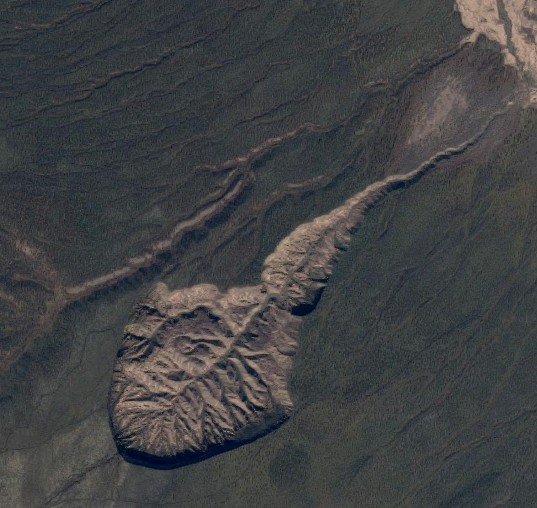About
The largest crater in Siberia, known as “the doorway to the underworld” or a “mega slump” depending on who you ask, is getting larger and deeper each year—a trend that brings with it both foreboding and promise.
The Batagaika crater first started to form as a result of deforestation in the area in the 1960s. Without the cooling effects of the trees, permafrost in the soil started to melt during warmer months, causing the soil to collapse and slump. As it melted, it released methane and carbon dioxide into the atmosphere, which increased the warming the area was experiencing, and caused deeper permafrost to melt and more soil to slump.
The slumping of the soil resulted in a phenomenon called “drunken trees,” an inability of trees to grow straight. Thus, as the area got warmer, the ground was also less protected from the warming, resulting in more melting, and so on. For this reason, the crater continues to grow and has expanded by between 30 and 100 feet every year for the past 10 years, depending on how warm a given year was. It is currently 0.6 miles long and about 280 feet deep.
The local Yakutian people, who gave it the nickname "the doorway to the underworld,” avoid the crater, but scientists are eager to study it. Scientists have nicknamed it the far less threatening “mega slump,” which is an enormous void that forms when permafrost rapidly thaws. The Batagaika crater is one of many mega slumps to appear recently in this area of Siberia; it is also the largest. It therefore offers many clues about the history and future of the area and of climate change.
Scientists believe the sediment layers in the crater could reveal up to 200,000 years of Earth history. Two bands indicating epochs of dense forests have been found in the sides of the crater, one indicating a time when the area was open tundra. The carcasses of a mammoth, a musk ox, and a 4,400-year-old horse have also been uncovered by the melting of the permafrost.
Evidence of the last time such craters opened up in the area—about 10,000 years ago at the end of Earth’s last ice age—and of what happened afterward give scientists an idea of what to expect and how to respond during this period of warming climate and melting permafrost.
Related Tags
Community Contributors
Added By
Published
March 23, 2017
Sources
- http://nypost.com/2017/02/28/climate-change-unfreezes-200000-year-old-doorway-to-hell/
- https://phys.org/news/2017-03-gateway-underworld-crater-scientists-earth.html
- http://news.nationalgeographic.com/2017/03/siberia-batagiaka-crater-climate-change/
- https://weather.com/news/climate/news/siberia-crater-climate-change-gateway-to-underworld
- http://www.sciencealert.com/siberia-s-huge-doorway-to-the-underworld-is-getting-so-big-it-s-uncovering-millennia-old-forests-and-carcasses
- http://www.bbc.com/earth/story/20170223-in-siberia-there-is-a-huge-crater-and-it-is-getting-bigger
- https://www.google.com/maps/place/67°34'48.0%22N+134°46'17.0%22E/@67.5547554,134.69615,10.81z/data=!4m5!3m4!1s0x0:0x0!8m2!3d67.58!4d134.7713889
- http://www.mnn.com/earth-matters/climate-weather/stories/what-megaslump-and-how-do-they-threaten-our-planet




















